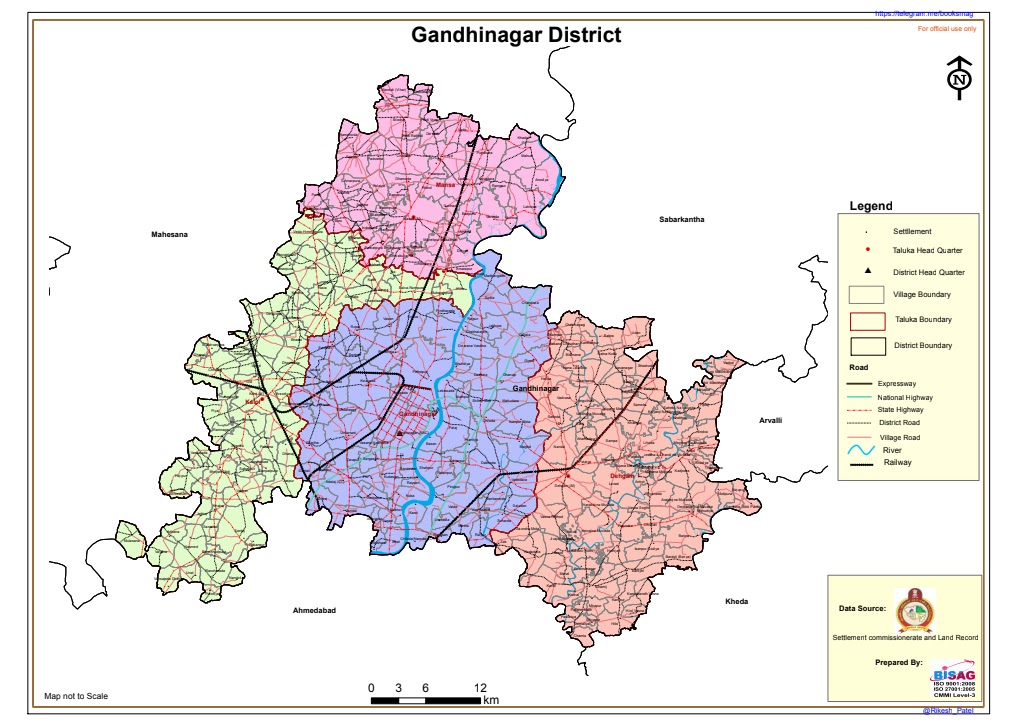Gandhiangar Dist Digital HD Map Pdf Download
Gandhinagar (About this soundpronunciation ) is the capital of the state of Gujarat in India. Gandhinagar is located approximately 23 km north of Ahmedabad, on the west central point of the Industrial corridor between Delhi, the political capital of India, and Mumbai, the financial capital of India.
Gandhinagar, Gujarat's new capital city, lies on the west bank of the Sabarmati River, about 545 km (338 miles) north of Mumbai, the financial capital of India and 901 km (560 miles) southwest of Delhi, the political capital.[4][better source needed] There is a provision of parks, extensive planting and a recreational area along the river giving the city a green garden-city atmosphere.[4][better source needed.
Gandhinagar has a tropical wet and dry climate with three main seasons: summer, monsoon and winter. The climate is generally dry and hot outside of the monsoon season. The weather is hot to severely hot from March to June when the maximum temperature stays in the range of 36 to 42 °C (97 to 108 °F), and the minimum in the range of 19 to 27 °C (66 to 81 °F). It is pleasant in the winter days and quite chilling in the night during December to February. The average maximum temperature is around 29 °C (84 °F), the average minimum is 14 °C (57 °F), and the climate is extremely dry. The southwest monsoon brings a humid climate from mid-June to mid-September. The average annual rainfall is around 803.4 mm (31.63 in).
The Akshardham temple is located in Gandhinagar. There was a determination to make Gandhinagar a purely Indian enterprise, partly because the state of Gujarat was the birthplace of Mahatma Gandhi. For this reason, the planning was done by two Indian town planners: Prakash M Apte and H. K. Mewada, who had apprenticed with Le Corbusier in Chandigarh.
Gandhinagar, Gujarat's new capital city, lies on the west bank of the Sabarmati River, about 545 km (338 miles) north of Mumbai, the financial capital of India and 901 km (560 miles) southwest of Delhi, the political capital.[4][better source needed] There is a provision of parks, extensive planting and a recreational area along the river giving the city a green garden-city atmosphere.[4][better source needed.
Gandhinagar has a tropical wet and dry climate with three main seasons: summer, monsoon and winter. The climate is generally dry and hot outside of the monsoon season. The weather is hot to severely hot from March to June when the maximum temperature stays in the range of 36 to 42 °C (97 to 108 °F), and the minimum in the range of 19 to 27 °C (66 to 81 °F). It is pleasant in the winter days and quite chilling in the night during December to February. The average maximum temperature is around 29 °C (84 °F), the average minimum is 14 °C (57 °F), and the climate is extremely dry. The southwest monsoon brings a humid climate from mid-June to mid-September. The average annual rainfall is around 803.4 mm (31.63 in).
The Akshardham temple is located in Gandhinagar. There was a determination to make Gandhinagar a purely Indian enterprise, partly because the state of Gujarat was the birthplace of Mahatma Gandhi. For this reason, the planning was done by two Indian town planners: Prakash M Apte and H. K. Mewada, who had apprenticed with Le Corbusier in Chandigarh.
IMPORTANT LINK::::

Post a Comment